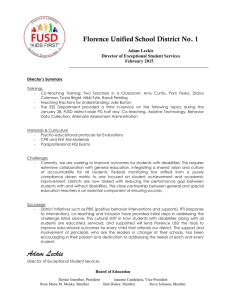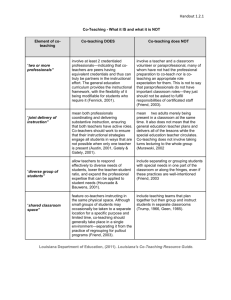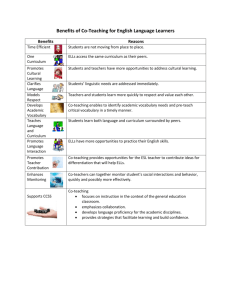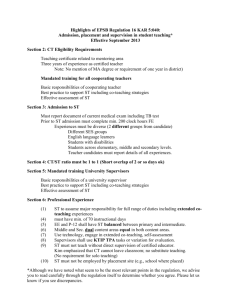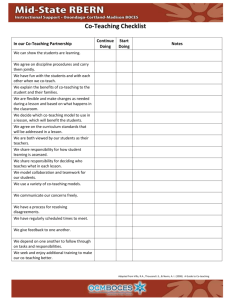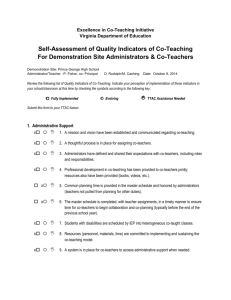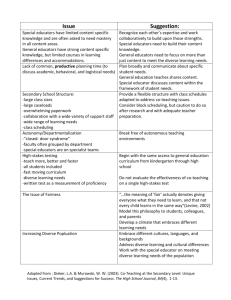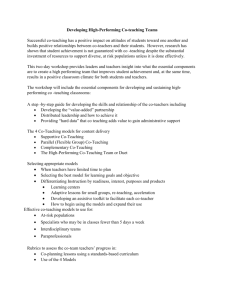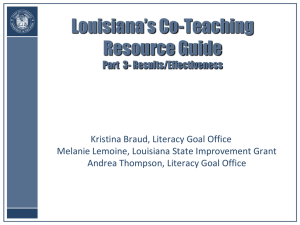ED602 Reflective Questions on Differentiation/Co
advertisement
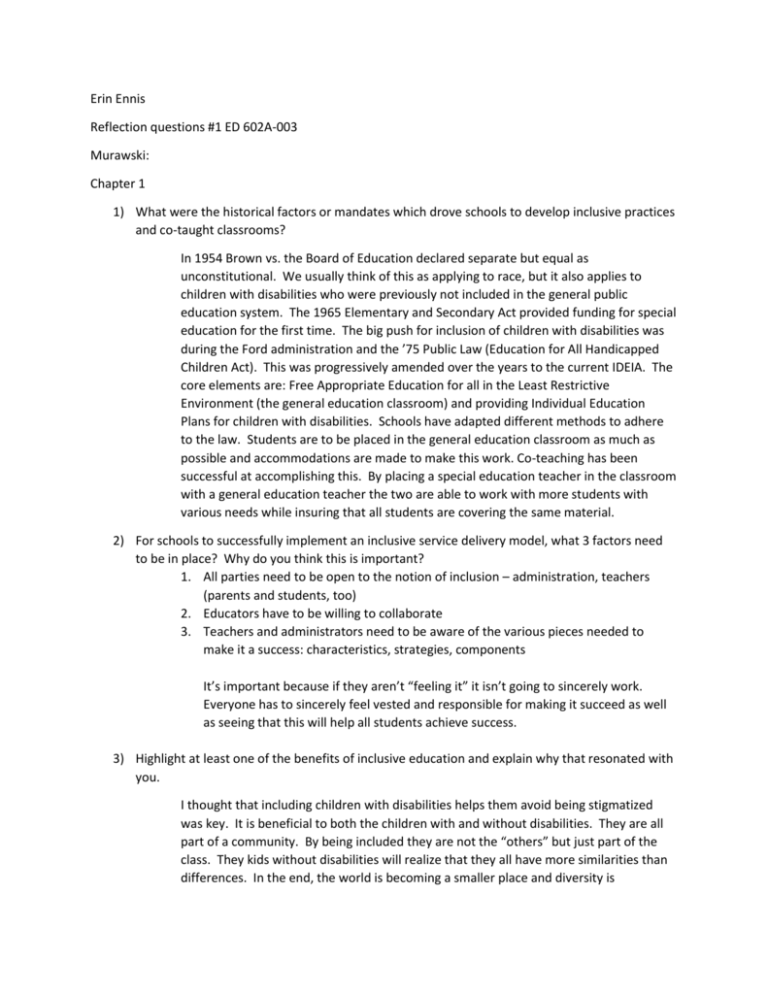
Erin Ennis Reflection questions #1 ED 602A-003 Murawski: Chapter 1 1) What were the historical factors or mandates which drove schools to develop inclusive practices and co-taught classrooms? In 1954 Brown vs. the Board of Education declared separate but equal as unconstitutional. We usually think of this as applying to race, but it also applies to children with disabilities who were previously not included in the general public education system. The 1965 Elementary and Secondary Act provided funding for special education for the first time. The big push for inclusion of children with disabilities was during the Ford administration and the ’75 Public Law (Education for All Handicapped Children Act). This was progressively amended over the years to the current IDEIA. The core elements are: Free Appropriate Education for all in the Least Restrictive Environment (the general education classroom) and providing Individual Education Plans for children with disabilities. Schools have adapted different methods to adhere to the law. Students are to be placed in the general education classroom as much as possible and accommodations are made to make this work. Co-teaching has been successful at accomplishing this. By placing a special education teacher in the classroom with a general education teacher the two are able to work with more students with various needs while insuring that all students are covering the same material. 2) For schools to successfully implement an inclusive service delivery model, what 3 factors need to be in place? Why do you think this is important? 1. All parties need to be open to the notion of inclusion – administration, teachers (parents and students, too) 2. Educators have to be willing to collaborate 3. Teachers and administrators need to be aware of the various pieces needed to make it a success: characteristics, strategies, components It’s important because if they aren’t “feeling it” it isn’t going to sincerely work. Everyone has to sincerely feel vested and responsible for making it succeed as well as seeing that this will help all students achieve success. 3) Highlight at least one of the benefits of inclusive education and explain why that resonated with you. I thought that including children with disabilities helps them avoid being stigmatized was key. It is beneficial to both the children with and without disabilities. They are all part of a community. By being included they are not the “others” but just part of the class. They kids without disabilities will realize that they all have more similarities than differences. In the end, the world is becoming a smaller place and diversity is everywhere. Children need to be exposed to people of all different backgrounds early on. 4) Why is collaboration so important in schools today? Highlight key features. The global economy and the job market seek employees with communication and interpersonal schools. Team work helps uncover different ways of approaching a problem resulting in higher levels of efficiency. Teachers modeling collaboration serves as a positive example of students. They see how important it is to work together. This passes down to students working in pairs or groups, too. Two heads are better than one. Chapter 2 1) Why is inclusion of students with disabilities ethically and educationally valid? Ethically it gives children access to equal opportunities for success. They are not in isolation. Life isn’t static – it is ever changing. Children can’t be taught in an environment where they are kept separate from the general population. Inclusion socially benefits all students. They are all exposed to the fact that people are individuals and realize that they all have something to bring to the table. Educationally, students are more engaged and higher self-confidence which results in higher academic performance. Modifications in the classroom for at risk students also benefit not at risk students. All students can benefit from a variety of teaching methods. 2) After reviewing the charts on the benefits of co-teacher, select one benefit for students and one for teachers and explain why it was important to you. Students with disabilities prefer to be in a general classroom with a co-teacher for a difficult subject versus being in resource time. They don’t want to be out of the classroom even if they are struggling with something. I thought this was very interesting. It shows that the students WANT to be challenged and that being included was so important to them that they were willing to push themselves (with assistance). Co-teaching saves on time for planning, etc. but also saves time with less spent on behavior management. Two teachers mean more time for individual attention and ability to keep students on task. Co-teaching appeals to my need for efficiency. More time can be spent teaching and learning than on non-beneficial activities. Chapter 3 1) How are teachers like Jupiter and Saturn? Please explain how these frames of reference can play out in a co-taught classroom. General teachers are like Jupiter because they have the largest classes and, like the red storm, are the first to weather new programs, mandates, etc. Special Education teachers are like Saturn because they are juggling many “rings” of influence and time management. They have to work with students across grades, subjects and with different needs. Their time is spent floating from place to place just like how Saturn is so light weight it would float. General teachers teach to the group, special education teachers teach to the individual. They bring different perspectives to the classroom and can learn a lot from each other. Co-teaching shrinks Jupiter’s influence but also makes the storm less severe since it’s spread out among 2, not just 1. Saturn’s rings shrink and gets more anchored. 2) How would you describe your frame of reference/suitcase? I am an only child raised by a single mom who remarried and divorced a 2nd time with my biological dad not really in the picture and my step dad very much so until they broke up after 13 years. We were poor and my mother was “thrifty”. I remember playing outside as TV time was limited and when it was allowed was only PBS. I lived in a small town with very little going on. I spent a lot of time with my head in books at the library and had a few good friends, but was not popular. I loved art and playing piano. I went to the local prep (boarding) school as a day student on scholarship. College was not an option – it was a necessity as a ticket out. Lots of rich kids, I was a smart kid. School is important. A lot of great teachers, small classrooms, personal attention and focus on college achievement. 3) Case study pgs. 45-6 1. 2 teachers: Ms. Taylor who seems inattentive and disengaged from the class (not coteaching) and Ms. Jones who tries to keep the peace in the classroom. The students involved are Katy, a poor child who has apparent behavior issues and Jamisha who is racially sensitive and unaware of Katy having any special needs. 2. Ms. Taylor doesn’t appear to want to or know how to deal with it. Ms. Jones, while trying to be calm and fair in how she treats Katy (by not blowing up at her outburst) comes across as giving preferential treatment to her. Katy comes from an unstable family with financial struggles and has behavioral problems. Jamisha also comes from a poor neighborhood as the school services these children. She is defensive. 3. The teachers are not co-teaching. Only one is addressing behavioral problems. The kids are not aware of how diverse their class is. Diversity is not celebrated or directly addressed – Ms. Jones is just treating them differently based on needs and, as a result, the class feels like she is not being fair. Dieker Chapter 1 1) What is the philosophy of an inclusive school? Describe the factors that contribute to one. An inclusive school adheres to Least Restrictive Environment. Maximum amount of time is to be spent in the general education classroom between children with and without disabilities. The environment needs to feel safe. Great teachers create a great climate with a common believe that all children can learn. Students learn in different ways at different rates and teachers need to be able to adapt to this. 2) How does an inclusive school deal with: a. Behavior? A universal system is put in place school wide to provide consistency and create general expectations by the students. They know how to behave across classrooms and what the consequences will be. b. Service delivery options? Lessons are designed upfront to accommodate different learners based on the Universal Design for Learning so they don’t have to constantly be modified. Themes are covered across content areas to provide repetition and demonstrate common threads in material (relevance). c. Learning environment? The goal is to get all children in the general classroom. If they are pulled out, the goal is to get them back in as soon as possible. There is an emphasis on peer work – among teachers and students – to encourage a “family” environment. 3) How is the concept of fairness incorporated by administrators, teachers, students, parents and the community in an inclusive school? Fairness is not “sameness.” This means that all students should be receiving the support they require to succeed based on their individual needs. One student may need an accommodation that another does not. Dieker likens it to a doctor’s prescription pad – a doctor is only going to prescribe treatment for a specific ailment to a specific patient. It is not going to apply to the general population. Anyone visiting the school should be able to see this in action in the school – everyone is helping everyone else. The school can serve as an example to the community at large as a place of embraced diversity. Dieker Chapter 2 1) What is the purpose of celebrating success and differences? There are opportunities for everyone to be celebrated based on their different strengths. Emphasis should be placed on the positive. This focus on the strengths of the individual students creates confidence and higher self-esteem which all can lead to more successes. Abilities are embraced rather than just grades. Every child has a talent to be acknowledged and encouraged. 2) List 4 different ways that student strengths can be celebrated in an inclusive school. 1. Newsletters home that include student work such as poems, art work, etc. and all students are given the opportunity to contribute. 2. Students are given different opportunities to demonstrate mastery of a standard. Rather than a written test, for example, they are tested orally, or technology is used. 3. Postcards are sent home with an accomplishment on it 4. Student exhibitions showing off their various gifts and interests celebrating their different abilities 3) How would you respond to a learning disabled student who engaged in self-advocacy to explain how he learned and what he needed to be successful in your classroom? I would be thrilled!! I would talk to him about mentoring other students and give him the opportunity to address the rest of the class. I think they could learn more from him directly than from me just discussing diversity in the classroom. He lives it and he is one of them. I would consult with him about what he thinks could improve his learning with me. By knowing how he learns, I will be aware of things he may be struggling with and adapt my teaching methods to serve him better. 4) Make a list of services that you think would be appropriate supports for students with disabilities in an inclusive school. - Modified assignments (alternatives) - Alternatives methods of learning: i.e. technology - Alternative grading methods - Bring in adults/college students with various disabilities to come and talk about their successes/stories - Mentoring programs - Provide alternative extra-curricular activities, i.e. adapted sports - Emphasize co-operative learning (peer groups both among teachers and students) - Co-teaching Dieker Chapter 3 1) What are the 8 characteristics reflective of a true interdisciplinary, collaborative secondary school? 1. Team accountability and empowerment for making changes 2. Co-teaching encouraged, but not mandated 3. Curriculum and IEPs are developed collaborative, not in isolation 4. Lessons based on Power Standards and universally designed for diverse learners 5. Peer observations 6. Value each other’s opinions (from observations, peer assessments) 7. Flexible services in general education as much as possible 8. Collaboration expected, rewarded and valued Essentially collaboration is not just encouraged but expected – assumed as part of the school climate. 2) What is Universal Design for Learning? The theme is that each student learns differently and that there need to be a variety of methods available to draw upon to address this. Adaptation can benefit all. An alternative means of conveying information for one could be beneficial for others in the classroom. 3) What is Supportive Collaboration and how does this facilitate inclusive education? It creates a truly welcoming environment. Teachers collaborate with each other and the result is thriving students. They share a common mission to help kids succeed and reach their full potential. There is open communication and teachers are entrusted to develop solutions on their own as they see fit depending on circumstances. Teachers work across content areas to create common threads so students can tie their learning together. This reinforces themes and creates relevancy. Collaborating teachers are working together to come up with solutions – again, two heads are better than one. 4) What does the author mean when she asks the question, “what kinds of paradigm shifts would be expected as a school moves toward a more inclusive learning community?” The philosophy of “together we are better” has to be embraced by all. The perspective of the world as a diverse place is found everywhere. Doors are left open and students and staff are found engaging each other in conversation and exchanges of ideas. Content and behavior has to be re-examined and adapted to fit this idea of a community of learners rather than children identified by their grade, abilities or challenges. Educators have to break the pattern of the “tried and true” ways of doing things and realize that there are other (better and possibly easier) ways of addressing more children. 5) Which elements of the inclusive practices were in place in your secondary school to promote the success of all students in a classroom? My school was small – my graduating class was less than 100 students. It also was a boarding school with a small number of day students (I was one), so parents were not able to be as involved as they are in other schools, so students relied on staff for support. We had early dismissals on Wednesdays (every Weds) so we could do homework and teachers could have office hours and work. I do not recall staff meetings, etc., but teachers and students all ate at the same time and together. Students were all assigned staff mentor who we sat with us during assemblies (every Monday morning) and “chapel” on Fridays (non-denominational). The staff were all involved with extra-curricular activities – sports, drama, social functions, etc. Wayland tried to create a “community”. Unfortunately, the disparities in economic backgrounds were had to address. Students on scholarships were apparent since we couldn’t exactly conceal that we were making copies for a teacher. The school sent newsletter regularly to parents; college counseling was mandated and the counselor walked us through applications and gave us calendars with application due dates for certain schools; teachers rotated dorm duties. Teachers had office hours much like college professors and made themselves very available to students. We had things like “Action Weekend” before school started which was supposed to be a bonding experience for new and old students and faculty. Events covered a range of interests from rafting to rock climbing and less physical activities. Everyone was required to take sports – phy. ed. wasn’t an option until we were juniors and seniors – and it gave students the opportunity to try something they normally wouldn’t have and discover hidden talents. That worked both ways, of course – it could be pretty demoralizing to have to take something and not be any good at any of the offerings for that season. Reflective Questions #2 Chapters 4 & 5 1) Describe the difference between consultation, collaboration, in-class support and co-teaching: Consultation- when 1 person assists another (providing expertise) Collaboration – when 2 professionals work together toward a common goal In-class support – not co-planning or co-assessing, just co-instructing; on the spot modifications, accommodations and assistance Co-teaching – 2 professionals co-plan, co-instruct and co-assess a diverse group of students in the same general education classroom 2) What are the advantages/disadvantages of each method? All 4 involve people working together which in and of itself is better (usually) than someone working on their own. Two heads are better than one… There’s the possibility of new (better) ideas that could come out of them. Co-teaching and collaboration go hand in hand. Both parties are professionals (so on equal footing with comparable credentials). Both are vested in achieving academic and social success for all of the students under their charge. They share duties and responsibilities in an equal fashion resulting in a more productive use of time spent on education rather than classroom management. They are better able to reach more kids in 1 setting. The biggest disadvantage would be in the teachers’ themselves embracing the idea of working together in a shared environment. In-class support – There is a lack of commitment to each other resulting in not giving 100% demonstrated by the one-sided imbalance of “power” over the classroom. Planning is not proactive as they are not planning ahead on a way to universally address all needs, but doing so on the spot. They do not have a common goal set so that they are both united in working towards it – it’s more of a day to day arrangement. There isn’t shared decision making. It’s a step in the right direction, but no parity. Consultation is the weakest of these. It’s just one person giving advice to another. It’s not a shared effort with no shared feeling of responsibility. Essentially it would be me just telling you that I think “X” would be a better way to do something. One person is more the “expert” than 2 people sharing ideas back and forth. 3) Chart 5.3 pg. 72 Lectures Writes on board Reviews timelines/dates Assigns homework Reviews for test Gives new vocab Gives test Teaches complex info Takes roll Reviews homework Disciplines student Circulates around class Leaves to copy materials Reads aloud Gives silent sustained reading time Creates cooperative learning groups Creates rotating stations Assigns differentiated work Gives directions Identifies standard to address Works with small group Writes on overhead Collects classwork Proximity or writing down key notes on overhead/board Be explaining what materials need to be out, what’s next Write them down Write it down, walk around checking to make sure it’s being written down (help if not) Break into groups with those who benefit from a different type of review Write it down, give example (picture, use word in sentence) Work with alternative test taking students Write down notes, have handout with break down, take a group to break it down more Go over Do Now, collect homework Check around room to see who did it Keep class going – redirect rest to keep on task Present new activity/instruction opportunity Activity time (schedule it in) Sit with group and follow along with the passage written down Make sure students have reading level appropriate materials, use time for technology resource time with students who struggle with reading Work with transitions to groups to keep quiet, split work with who is monitoring which group Work with one or more stations and other teacher is with the others Work with different groups to make sure they understand what their assignments are Give alternative directions/write them down Break it down to give meaning to students Works with bigger group on related thing Reads off of it/circulates to check for comprehension/paying attention Go over what class will do next 3 Key things to insure parity: Communication; Collaboration; Sharing of ideas, tasks and space Chapter 6 1) What is a paraprofessional? What are reasonable expectations for a paraprofessional? Explain why? A paraprofessional works directly under licensed professionals. They service, augment and assist the general education teacher. They are not responsible for planning or assessing, but possibly collaborating and co-instructing. Their role is more to facilitate small groups and individuals and model. Adhering to standards and writing lesson plans are the teacher’s responsibility. The paraprofessional can participate, but ultimately it is up to the classroom teacher to determine what/how material is taught. The paraprofessional has not received the training/education that the teacher has and cannot be expected to perform the same job. 2) What is the general education teacher’s role when working with a paraprofessional? The general ed teacher introduces new material, plans, assesses and instructs. They include the paraprofessional in the process for input and define who will do what. 3) What stakeholders should be informed regarding your co-taught class and why? The stakeholders are the district/school board, non-teaching staff at the school, the surrounding community and businesses. The co-taught class can serve as an example of inclusion in today’s diverse society. It can have a radiating effect – starts in the class and moves through the school and into the community at large. The co-taught class makes it possible to adhere to IDEA which should be a strong reason for the district to support it. By seeing successes in the co-taught class, they may provide additional financial and resource support (classroom materials, teacher training, etc.) The local community can be tapped into as a resource for support as well. She sites examples of businesses donating various materials such as school supplies, older computers, gift certificates, books, etc. 4) How might you inform these various stakeholder? The best way to solicit support is face to face. It’s harder to say no if someone is standing right in front of you and it shows that they are dedicated to their cause enough to take time to get out into the community. It provides a personal touch and helps create a community connection. A letter or card (hand written card, signed letter addressed to the recipient – not a form letter) has an impact as well, especially in today’s world of electronic messages. Mailing something takes more effort and this can help make a better impression – hopefully enough of one to get a response. Emails can be short and sweet and sent out periodically with minimal effort and expense, but I would use them as a follow up. I think maybe a short newsletter would be effective, too. It could be partially written by the students and show what they are doing both in school and out in the community. It shows those who are supporting the classroom where their assistance is going and encourages to 1) continue their support and 2) tell others about it. Chapters 7 & 8 1) Why is goal setting important and how does one set appropriate goals? The steps to setting goals: 1. Needs assessment where the school/class‘s strengths and weaknesses are identified; a plan is developed; funds and resources are allocated; students, parents, administration and teachers are involved. 2. Collaboration takes place where decisions about what duties should be shared and what should not occurs. Collaboration encompasses communication and coming up with a mutual outcome for student development in the diverse classroom. 3. The questions of how and when assessments will take place is addressed. How will you know when the goal has been met or if you are on the right path? 4. Both parties have to have a shared sense of responsibility and commitment in attaining the goal. 5. There has to be a Plan B if the goal is not being met or, if over the course of time, the goal does not seem appropriate/attainable/relevant, something else is in place to be working for or an alternative way to reach the original goal. 6. The goal has to be clearly stated with a clear expected outcome. 7. Goals need to be set for both students and instructors – students need to meet academic standards, but teachers need to have a goal for themselves, such as successfully sharing and receiving feedback – something they feel they need to strive for. Goals are a way of creating team cohesion between the co-teachers. They focus instruction and insure parity if they are set properly with realistic expectations. 2) What steps could an administrator take to support a co-teaching model? - Let teachers select their own partner - Provide training (to all, not just participants as school is an inclusive environment and all should be aware of what co-teaching entails) - Provide co-planning time for co-teachers - Prepare teachers for it – give it time to be set up and for the staff to be prepared/educated about it, don’t just pop it on them like another mandate - Make it clear that this is permanent - Cap the class size (not to be changed with enrollment – it’s a fixed size) - Incent teachers: the initial preparation for the co-taught room takes time, so compensate teachers for it o Additional pay o Extra funds for materials o Less other duties (lunch duty, etc.) o Recognition in their file - Survey staff, students and parents (all staff, not just teachers) at various times after it has been implementing to gage how things are going Chapter 9 1) What 3 areas should co-teachers address before co-teaching and why? a. Physical space because they need to decide who will be where and make accommodations for students with physical limitations. By having seating arrangements and the classroom planned before school will save time in the long run. b. Classroom management needs to be agreed upon before class starts because they need to be on the same page as a unified unit for the students. This will create a productive, controlled environment with clear expectations. This prevents children using “mom” against “dad”. Students will know that expectations and consequences will be the same with either teacher. Basics such as homework collection, daily routine, taking attendance, etc. are best set up at this time, too. It will save on time and will create a more seamless transition for students into a co-taught room. They will know what to expect day to day regardless of who is in front of the class. Having these things in place prior to the first day of school is just good policy as it prevents scrambling to come up with something on the spot and will provide consistency. c. Instructional and assessment issues need to be addressed. This, again, is to save time as teachers have enough to do day to day. Trying to figure out who will do what and how they will each do it on a case by case basis will take way too much time. It’s much easier to come up with clear duties of who will do what, who will implement material and how to do so. They can gather information on their new students and join forces to come up with a plan that will encompass all learning styles. This is when they can work out each other’s work preferences and teaching styles and see how to mesh them together. It’s the foundation of a year of collaboration – the groundwork is laid here. 2) In the area of classroom management, provide 2 proactive and 2 reactive strategies that you like and why? Proactive: 1. Hall pass with hole punches (3/semester) – I like this because it has limitations (only 3) so they have to think twice before using it for something trivial, it is nondisruptive (no hand raising, speaking out – just drop it off and go), it gives children autonomy to decide when they will use it and why and trusts that they will return in 5 minutes allotted. 2. Golf pencils – They are cheap and students will be encouraged to bring their own writing instruments because they will not want to walk around school with these. I also like the idea of having supplies in my room and charging a nominal fee. My practicum teacher has composition notebooks for .10. It something so they don’t take advantage of it, but not at all expensive so attainable. Reactive: 1. Posting “Fair is not equal” and explain what it means. It is FAIR that all students are receive what they need to learn and that this is not the same for everyone. I really like the example of the doctor’s prescription pad. Not everyone needs medicine and not everyone will need the same medicine. 2. Send the child who is having difficulty focusing or is acting out on an “errand” on the other side of the building. Once the procedure is established between the teachers involved, I think it would work. It’s always good to be able to let off a little steam. I have a child with ADHD and sometimes he just needs a break and sitting still is not as relaxing to him as being able to move around. 3) What is HALO and how does co-teaching facilitate its implementation? HALO stands for High achievers, Average achievers, Low achievers and Others. Keeping it in mind helps teachers create differentiation in lessons. It is easier to address a wide range of achievers in a co-taught room because 1. it makes group work possible since it’s easier to monitor with 2 teachers and group work is proven to be beneficial for students with different abilities and learning styles 2. teachers can divide and conquer giving them more time to get to know individual students and can then share what they know with each other 3. by having 2 teachers it’s easier to learn what learning styles are working or not for individual students and to identify strategies early on 4. 2 teachers make using different methods and strategies easier to implement because more time is spent on instruction than on classroom management Chapter 11 1) Why is co-planning so important for effective service delivery in a co-taught classroom or in collaborative teaching relationships? One teacher is an expert in content and the other in special delivery. By having the same goal they can then use their expertise to form a plan together which will address a diverse room. Co-planning creates parity – they both have a voice in how a unit or lesson will come to life. The content is only as affective as how it is delivered and how it is received. 2) What are the benefits of co-planning? Co-planning insures variety and differentiation in strategies for different kids so all have access to the information effectively. It creates inclusive lessons and learning. 3) What are the barriers to co-planning? What ideas do you have for overcoming these barriers? Time seems to be the big one. Having enough time to plan with another teacher and enough time to implement new strategies. Time needs to be spent on training, too. This needs to be addressed with the administration and a plan needs to be put in place to allow for co-planning time. Seasoned teachers seem to teach “off the cuff” because they have covered the material so many times they don’t have a written plan. This will not be a problem for me – I’m new and will have detailed plans – but just having a written plan seems to be the best place to start with co-planning. If the content teacher has a written plan, then they both can go over it and “tweak” it to address a diverse classroom. They have something to work with and don’t have to start from scratch. The focus is on the delivery, then, rather than coming up with the content. Chapter 16 1) Explain how co-teaching supports or enhances: a. Smaller Learning Communities – Because they are small, teachers already are more familiar with each other and their students. This environment is conducive to coteaching because a special education teacher can provide support to more than one teacher at a time because they share students. b. Cooperative learning – This is easier to do with a co-teacher. It’s harder to implement with just one because organizing and structuring transitions, noise levels, different student personalities, etc., takes time. It would be much more accessible with 2 teachers sharing the responsibilities and co-creating the environment and management. c. 21st century technology usage – All of the new technology available today means that many (of us) are not well versed on everything available. The co-teachers can divide up who will be the “expert” on which piece of relevant technology. The SE can take on the role as the tech person in the class and share their knowledge with the class and the content teacher. This can be a good division of duties if the SE is not comfortable with the content. They can work together to pair which students with which learning tool. 2 adults in the classroom also helps to police the use of technology keeping kids off of inappropriate websites or from texting during a lesson. d. Understanding by Design – Instead of adapting WHEN you get a student the lessons are designed for a diverse group of learners. Co-teaching means co-planning so lessons should be set up to address differentiation from the get go. The 2 go hand in hand. Coteaching insures that lessons will work with different students because they incorporate a variety of strategies. e. Response to Intervention – Data collection is at the core of RTI. Having 2 teachers in a classroom with different areas of expertise makes this easy. There is more time for data collection and immediately there are 2 opinions involved – one may be seeing something that the other is not. Co-planning results in UbD lessons. The goal of RTI is inclusion as is the point of co-teaching. Everything comes together here – if the lessons are designed to reach a wide range of students, the co-teachers are working together to assess students, and more students are able to access taught material more students should stay in the general education classroom. 2 teachers in the room also makes having more individual and small group work possible while remaining in the room. There is no need for an SE or SEA to come in and pull out a student if there is already someone in the classroom to work with these students. The process of assessing for level 2 and 3 students also is easier because 2 professionals are observing the same students at the same time all of the time.
